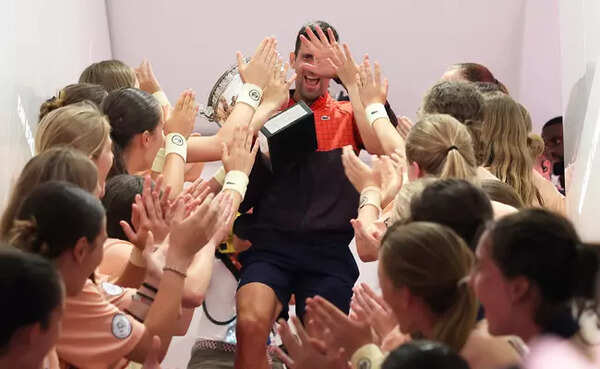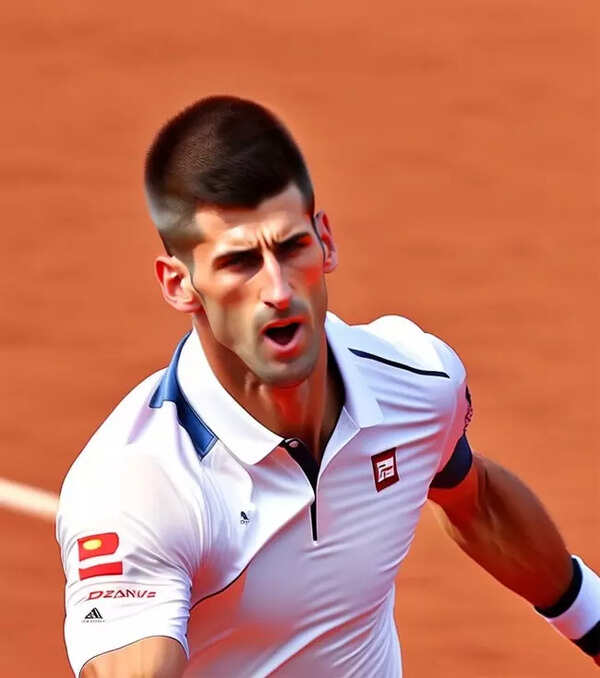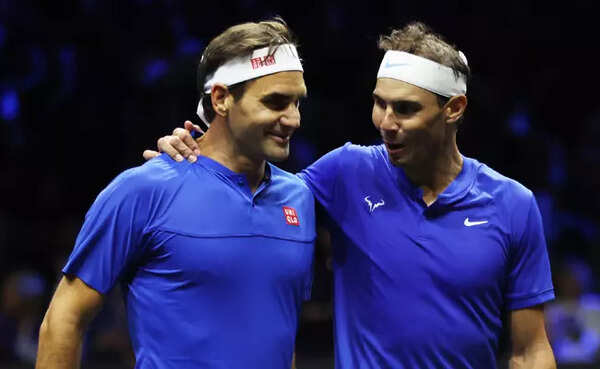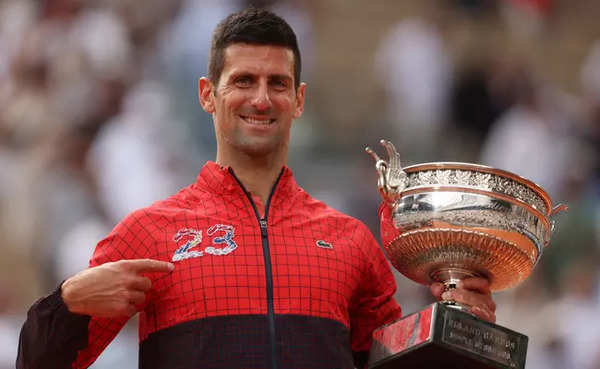What the ‘Djoker’ has achieved is no laughing matter, but he is not the G.O.A.T. | Tennis News – Times of India
January 27, 2008. A 20 year old Djokovic, seeded 3rd, wins his first Grand Slamtitle beating Jo Wilfried Tsonga in 4 sets in the Australian Open men’s singles final. The final was supposed to be a Federer vs Nadal affair, but the two big ‘favourites’ were humbled in the semi-finals.Djokovic beat top seed Federer in straight sets and Tsonga thrashed the 2nd seeded Rafa 6-2, 6-3, 6-2. For many sports journalists it was in many ways reminiscent of the 2007 ICC ODI World Cup, when Bangladesh and Ireland pipped India and Pakistan to the Super Eight stage.
But to understand Djokovic’s meteoric rise in men’s tennis we will have to go back to the beginning. He turned professional in 2003, at the age of 15. This was the year Federer won the first of his 20 Grand Slam titles. The Swiss maestro and his long time nemesis, the Spanish gladiator Rafael Nadal were busy establishing their absolute dominance in men’s tennis.
Rafa would win his first Slam title two years later in 2005 on the clay courts of Roland Garros. The same year, Djokovic made his maiden appearance at a Grand Slam – qualifying for the Australian Open. He would be bested by eventual champion Marat Safin in straight sets in the first round.
By 2006, the Serb was the youngest player in the World’s top 40. This was also the time when Great Britain’s Lawn Tennis Association was trying to get Djokovic to play for GB, alongside other Britons including his good friend Andy Murray. The talks between his mother Dijana and the LTA began during a Davis Cup tie between Serbia and Montenegro and Britain in April that year. Djokovic, a teenager at that time, eventually of course chose to continue representing Serbia, despite GB having way better facilities.
By this time he was yet to win a Grand Slam title of course, but a Slam title is indication of talent and success only to the lay fan. For those who follow the sport and the players seriously, Djokovic was already hot property, despite his best Grand Slam performance at that time being a quarter-final appearance at the French Open, followed by a fourth round exit at Wimbledon. Three weeks after Wimbledon he won his first ATP title – the Dutch Open, without dropping a set.
By 2007, Djokovic was still losing matches to Federer and Nadal, but was also managing to hold his own against the ‘Big 2’. Like in the Canadian Open that year when he beat Rafa in the semis and Federer in the final, shortly after withdrawing from his Wimbledon semi-final clash vs Nadal due to an elbow niggle, with the match poised at 1 set apiece.
After the Australian Open crown in 2008 and his first season ending championship title that year Djokovic didn’t win a Slam title till 2011. But he was making huge and very rapid strides. In 2009 he entered 10 finals and won 5 titles. He was consistently entering the knockout rounds of the big tournaments and Slams. At the 2010 US Open he beat Federer in the semis for his first win against the 20 time Grand Slam champion at Flushing Meadows and the first at a Slam since the 2008 Australian Open, before losing to Nadal in the final.

Novak Djokovic, Jelena Djokovic and their children pose with the winners trophy. (Getty Images)
In many ways, 2011 was his watershed year in terms of global recognition. With chants of ‘Nole’ reverberating across tennis stadiums the world over, Djokovic bagged the Australian Open, Wimbledon and US Open titles. He went on a 41 match win streak and ended the year as the World Number 1. A very strong message had been sent out to the ‘Big 2’ that they now had an extremely serious contender. Slam titles aren’t always a measure of success, but they are what the greats are remembered for. And Djokovic was winning them far more consistently now.
Cut to 2023, when he stands at the very top of the men’s tennis pyramid, with a mind boggling 23 Grand Slam titles, won in the course of 15 years. There are still two Slams left to be played this year and remember that he didn’t win a Slam title in 3 of the years since he won his first (2009, 2010 and 2017. In 2017 he made sweeping changes to his support staff and had a long injury break due to the problematic elbow for which he underwent surgery in early 2018)
How many Slam titles will he eventually end up with?
While his racquet took care of the serious business, it was very interesting to see how Djokovic would try and go out of his way to entertain the crowds in his initial years. He picked up the nickname – ‘The Djoker’ because of his on-court funny antics. It was almost as if he thought his tennis was not good enough to win him fans. For the longest time one could see that though he was winning the big titles, he knew that the global tennis fans (barring the Serbian fans) were essentially divided into two groups – the Federer fans and the Nadal fans. And he desperately wanted to belong.

Djokovic returns to the locker room with the winners trophy after victory against Ruud. (Getty Images)
Over the years, that insecurity seems to have disappeared. He no longer needs antics on court to win over fans. He has realised that the numbers should speak for themselves. And they do. He stands 3 Slam titles clear of Federer, 1 ahead of Nadal and 9 clear of Pete Sampras. He has finished the year as Number 1 seven times, which is two more than Federer and Rafa’s numbers. There have been 387 weeks that have seen Djokovic as the World Number 1. That’s 77 weeks more than Federer’s 310 and 10 more than Steffi Graf’s 377, which makes it the all-time high. Federer has retired and Nadal’s retirement is imminent. His career trajectory is the very definition of greatness.
He left the rest of the pack behind very quickly. Tsonga, who he beat in the 2008 Australian Open final bid adieu to the game last year after a first round loss at the French Open. He didn’t win a Slam title. That 2008 Australian Open final he lost to Djokovic was the only Slam final he played. The likes of Murray and Wawrinka flattered to deceive for a while as possible contenders but couldn’t match Djokovic’s drive and determination. Federer and Nadal would have known a while back that Djokovic would outstrip them as far as the numbers are concerned.
The titles though have not brought with them the legions of fans and undying support that Federer and Nadal enjoy. The controversies of course haven’t helped. Be it his fits of temper during matches, accidentally hitting a line judge in the throat with a ball which saw him being disqualified from the 2020 US Open, organising a series of exhibition matches at the peak of the Covid-19 pandemic, his anti-vaccine stand, being criticised by opponents for asking for medical assistance when they felt he was struggling during matches or when he controversially said that the properties of water and food can be changed through positive thinking.

He made sure that the ‘Big 2’ became the ‘Big 3’, but he has also been called the ‘most alienating of the Big 3’. Perhaps a good indicator of this are his off-court earnings courtesy advertisements and promotions, which according to Forbes stand at $340 million currently as compared to Nadal’s $390 million and the most loved of the Big 3 – Federer’s mind-boggling $990 million. On the court though, Djokovic has earned more in prize money than the other two of the Big 3.
As far as his tennis skills are concerned, for many he is already the ‘Greatest of all Time’. But that is a problematic statement.
The G.O.A.T debate is one that is common across sports. It keeps fans engaged and entertained, makes them follow the achievements and accomplishments of their favourite athletes and their biggest rivals closely and adds a lot of spice to the curry that is global sport.
But is it fair to compare an athlete of this era with one who played say 100 years ago? Even if we narrow down this debate to include only those who have played since the Open Era in tennis began in 1968, which essentially saw professionals take over the sport, can we realistically compare John Newcombe or Rod Laver or Bjorn Borg or Jimmy Connors to Federer, Nadal or Djokovic? No, we can’t. And we shouldn’t.

Can we actually compare players who first played with wooden racquets with loose strings to the modern day tennis players whose graphite racquets weigh much less than what the original wooden ones weighed? Players these days can choose between a full graphite racquet if it’s brute power they are looking for or a composite frame made of a combination of graphite fibers and Boron, Kevlar or fiberglass that distributes the weight in a much more efficient manner and gives the racquets a bigger ‘sweet spot’.
Even when Rod Laver won a calendar Slam (all four Grand Slams in the same year) twice in 1962 (pre-Open Era) and 1969 (Post-Open Era) he was using a wooden racquet – the Dunlop Maxply racquet, which he incidentally gifted to Federer in 2018. It was only in the 1970s and early 80s that wooden racquets were phased out.
Also players now compete across different surfaces. There was a time when three of the four Slams – Australian Open, Wimbledoen and US Open – were all played on grass. The US Open went from grass to clay in 1975 to the hard courts in 1978, marking the beginning of the Slam era we are all familiar with which has the French Open as the only Grand Slam played on clay.
The training techniques, fitness regimes, diet, supplements, travel schedules, quality of coaching available, scientific and data driven analysis and guidance available these days makes the current era very very different from anything that was available even 2 decades ago, let alone a century.

Novak Djokovic celebrates with the winners trophy. (Getty Images)
Djokovic himself echoed that sentiment after winning the French Open and a record 23rd Slam title, when he said, – “I don’t want to say that I am the greatest, because I feel it’s disrespectful towards all the great champions in different eras of our sport that was played in completely different way(s) than it is played today.”
In many ways Djokovic himself has changed the sport. He has made sure that the trend of a dominator in men’s tennis continues. By the time Djokovic won 3 Slams in 2011, Federer and Nadal had won 25 Grand Slam titles between themselves. And the Serb was there to answer the question – who after the ‘Big 2’?
To call him the greatest of all time based only on the number of titles would be to discount what players in the previous era had to endure and tackle and what they achieved. Remember Margaret Court, playing in the 1960s and 70s won 24 singles Slam titles and a mind-boggling 64 Slam titles overall, including singles, doubles and mixed doubles. How many fans of this generation would say that Court was ‘greater’ than Serena Williams?
The G.O.A.T debate aside, what cannot be denied is that what a man once called the ‘Djoker’ has managed to do is no laughing matter. And his legacy is laced with a greatness that he himself is the architect of.
window.TimesApps = window.TimesApps || {}; var TimesApps = window.TimesApps; TimesApps.toiPlusEvents = function(config) { var isConfigAvailable = "toiplus_site_settings" in f && "isFBCampaignActive" in f.toiplus_site_settings && "isGoogleCampaignActive" in f.toiplus_site_settings; var isPrimeUser = window.isPrime; if (isConfigAvailable && !isPrimeUser) { loadGtagEvents(f.toiplus_site_settings.isGoogleCampaignActive); loadFBEvents(f.toiplus_site_settings.isFBCampaignActive); } else { var JarvisUrl="https://jarvis.indiatimes.com/v1/feeds/toi_plus/site_settings/643526e21443833f0c454615?db_env=published"; window.getFromClient(JarvisUrl, function(config){ if (config) { loadGtagEvents(config?.isGoogleCampaignActive); loadFBEvents(config?.isFBCampaignActive); } }) } }; })( window, document, 'script', );
For all the latest Sports News Click Here

